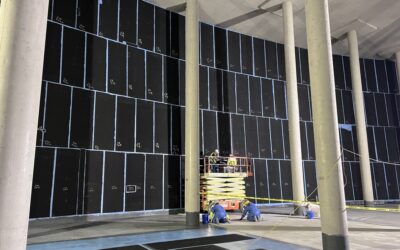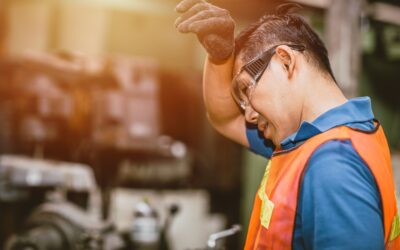Rubber linings are beneficial for protecting industrial equipment such as storage tanks, pipes, and processing vessels from corrosion. But over time, even the most durable rubber linings can deteriorate, leading to the important decision of whether to repair or replace them.
Key Factors in Deciding Between Rubber Lining Repair and Replacement
There are several key factors to consider when making this decision, including the age of the lining, extent of damage, and environmental conditions. By understanding these factors, businesses can ensure optimal tank lining maintenance.
1. Age of the Rubber Lining
While the lifespan of rubber linings varies in different environments, the typical rubber lining lifespan ranges from 5 to 30 years. Recognizing the following signs of aging allows for proactive measures to repair or replace linings before they deteriorate and lead to costly failures.
Hardening and Cracking
Over time, heat, sunlight, and chemicals can make rubber linings hard and brittle. When this happens, the rubber loses its flexibility and is more likely to crack under pressure or temperature changes. Brittle rubber also can’t absorb shocks or vibrations as well, which increases the risk of damage. Cracks in the rubber can let in water or other substances, causing even more wear and tear.
Loss of Elasticity
Elasticity allows rubber linings to stretch and move without breaking when equipment shifts, expands, or changes pressure. However, over time, exposure to extreme temperatures, harsh chemicals, and oxygen can weaken the rubber, making it lose its flexibility. When this happens, the rubber becomes stiff and brittle, making it more likely to tear, crack, or develop holes.
Surface Degradation
The outer layer of a rubber lining acts like a shield, protecting equipment from harsh chemicals, rough materials, and physical damage. However, over time, exposure to these elements can wear down this protective layer, a process known as surface degradation. This can cause the rubber to become thinner, rough, or uneven. Signs of damage may include cracks, small holes, fading, or changes in texture. If the rubber lining starts to separate from the equipment, it won’t provide the same level of protection.
2. Extent of Damage
Not all damage to a rubber lining means it needs to be completely replaced. In many cases, small cracks, tiny holes, or minor surface wear can be fixed with patching or re-coating. If a crack or puncture is only in one spot, it can usually be sealed without replacing the whole lining. Minor surface degradation that hasn’t deeply affected the lining’s structure can also be treated to extend its life. Additionally, if chemical exposure damage is limited to just one section, targeted repairs can restore protection and maintain the lining’s performance.
However, there are times when rubber lining replacement is the better option. If the lining has large cracks, deep abrasions, or widespread damage, repairs may not be reliable in the long run. When multiple areas of damage keep appearing and requiring frequent patching, the cost and effort of ongoing repairs can add up, making full replacement more practical. Most importantly, if the lining’s structural integrity is compromised, there’s a high risk of leaks or failure. In this case, replacing the entire lining is the safest choice.
3. Environmental and Safety Considerations
When deciding whether to repair or replace a rubber lining, it’s crucial to consider the broader impact on the environment. Rubber linings play a key role in maintaining the integrity of equipment and avoiding risk to the environment or public health.
A well-maintained rubber lining helps prevent chemical or hazardous material leaks that could contaminate the surrounding environment. In industries such as chemical processing or oil and gas, even minor damage to a lining can lead to dangerous leaks, causing environmental harm.
These risks pose a threat to workers. Replacing a worn-out lining with a new, reliable one can significantly reduce safety hazards, ensuring that employees are protected from the risks of exposure to hazardous chemicals or pressurized systems. Additionally, industries with strict safety and regulatory compliance must ensure that repaired linings meet safety standards. In cases where a compromised lining risks product contamination or environmental hazards, full rubber lining replacement is often the safer option.
4. Mitigating Risk of Catastrophic Events
In industries like petrochemical, nuclear power, and mining, rubber linings enhance durability, ensuring that they remain intact even under extreme conditions. This helps prevent catastrophic failures that could pose a danger to both the facility and the broader community. By safeguarding both equipment and the environment, rubber linings help ensure broader safety beyond just protecting workers, reducing the likelihood of accidents that could have far-reaching impacts.
Is It Cheaper to Repair or Replace a Rubber Lining?
Deciding whether to repair or replace a rubber lining depends on both short-term and long-term costs. Repairs are usually cheaper upfront and can include methods like patching, vulcanization, or re-coating. These techniques can extend the life of the lining if the damage is minor, but they may not always be a lasting solution. Over time, repeated repairs can add up, especially if the lining continues to wear down or new damage keeps appearing.
In some cases, replacement is the more cost-effective option. If a lining needs frequent repairs, the ongoing costs of materials, labor, and downtime can become more expensive than installing a new lining. Replacing the entire lining also helps prevent unexpected failures that could disrupt operations and lead to bigger expenses. While the upfront cost of a new lining is higher, it often saves money in the long run by providing better durability, fewer maintenance needs, and improved performance.
Benefits of Rubber Lining Replacement:
Replacing a rubber lining offers several long-term benefits, making it a great investment for industries that rely on tank lining maintenance.
- Enhanced durability helps extend the lifespan of equipment by protecting it from wear, corrosion, and chemical damage.
- Improved chemical resistance ensures better protection in harsh environments.
- Reduced maintenance costs over time by minimizing the need for frequent repairs and downtime.
Benefits of Rubber Lining Repairs:
Rubber lining repairs can be a cost-effective solution, especially for minor damage.
- Lower upfront costs as repairs are more affordable than full replacements.
- Minimal downtime from quick repairs keeps operations running smoothly.
- Preservation of intact areas maximizes the full lifespan of the lining.
Should I Repair or Replace My Rubber Lining?
Deciding whether to repair or replace your rubber lining requires a careful evaluation of the condition of your equipment. If you need expert advice, contact US RUBBER today for an in-depth evaluation and the best solution tailored to your needs! Our professional rubber lining specialists can provide a professional assessment based on your specific situation.







